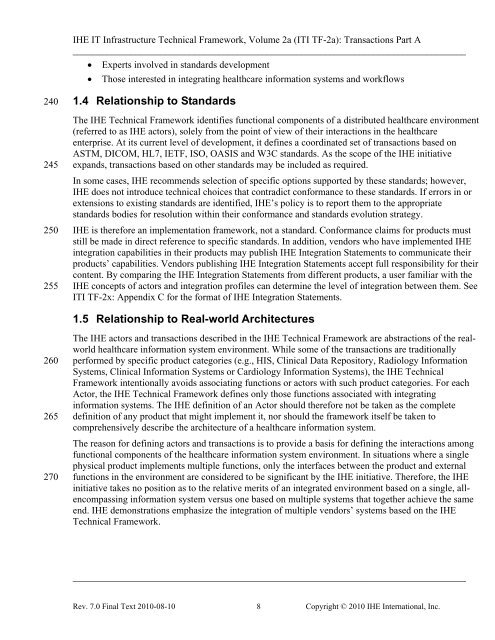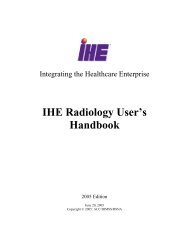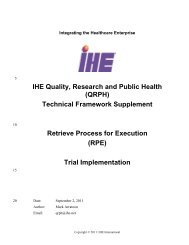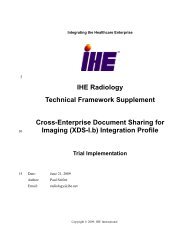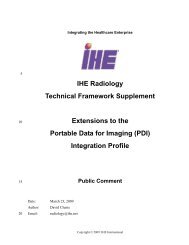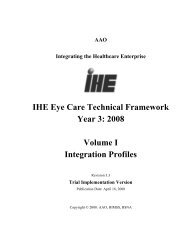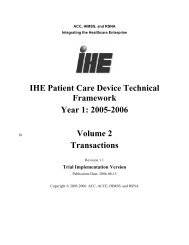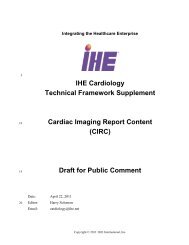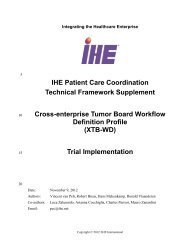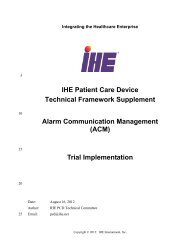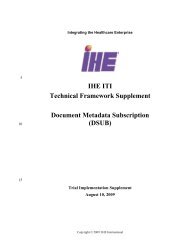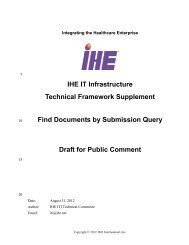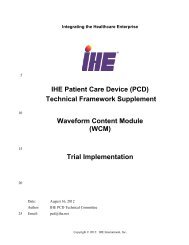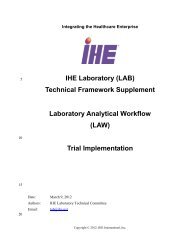ITI Technical Framework - IHE
ITI Technical Framework - IHE
ITI Technical Framework - IHE
Create successful ePaper yourself
Turn your PDF publications into a flip-book with our unique Google optimized e-Paper software.
<strong>IHE</strong> IT Infrastructure <strong>Technical</strong> <strong>Framework</strong>, Volume 2a (<strong>ITI</strong> TF-2a): Transactions Part A_________________________________________________________________________________• Experts involved in standards development• Those interested in integrating healthcare information systems and workflows2402452502551.4 Relationship to StandardsThe <strong>IHE</strong> <strong>Technical</strong> <strong>Framework</strong> identifies functional components of a distributed healthcare environment(referred to as <strong>IHE</strong> actors), solely from the point of view of their interactions in the healthcareenterprise. At its current level of development, it defines a coordinated set of transactions based onASTM, DICOM, HL7, IETF, ISO, OASIS and W3C standards. As the scope of the <strong>IHE</strong> initiativeexpands, transactions based on other standards may be included as required.In some cases, <strong>IHE</strong> recommends selection of specific options supported by these standards; however,<strong>IHE</strong> does not introduce technical choices that contradict conformance to these standards. If errors in orextensions to existing standards are identified, <strong>IHE</strong>’s policy is to report them to the appropriatestandards bodies for resolution within their conformance and standards evolution strategy.<strong>IHE</strong> is therefore an implementation framework, not a standard. Conformance claims for products muststill be made in direct reference to specific standards. In addition, vendors who have implemented <strong>IHE</strong>integration capabilities in their products may publish <strong>IHE</strong> Integration Statements to communicate theirproducts’ capabilities. Vendors publishing <strong>IHE</strong> Integration Statements accept full responsibility for theircontent. By comparing the <strong>IHE</strong> Integration Statements from different products, a user familiar with the<strong>IHE</strong> concepts of actors and integration profiles can determine the level of integration between them. See<strong>ITI</strong> TF-2x: Appendix C for the format of <strong>IHE</strong> Integration Statements.1.5 Relationship to Real-world Architectures260265270The <strong>IHE</strong> actors and transactions described in the <strong>IHE</strong> <strong>Technical</strong> <strong>Framework</strong> are abstractions of the realworldhealthcare information system environment. While some of the transactions are traditionallyperformed by specific product categories (e.g., HIS, Clinical Data Repository, Radiology InformationSystems, Clinical Information Systems or Cardiology Information Systems), the <strong>IHE</strong> <strong>Technical</strong><strong>Framework</strong> intentionally avoids associating functions or actors with such product categories. For eachActor, the <strong>IHE</strong> <strong>Technical</strong> <strong>Framework</strong> defines only those functions associated with integratinginformation systems. The <strong>IHE</strong> definition of an Actor should therefore not be taken as the completedefinition of any product that might implement it, nor should the framework itself be taken tocomprehensively describe the architecture of a healthcare information system.The reason for defining actors and transactions is to provide a basis for defining the interactions amongfunctional components of the healthcare information system environment. In situations where a singlephysical product implements multiple functions, only the interfaces between the product and externalfunctions in the environment are considered to be significant by the <strong>IHE</strong> initiative. Therefore, the <strong>IHE</strong>initiative takes no position as to the relative merits of an integrated environment based on a single, allencompassinginformation system versus one based on multiple systems that together achieve the sameend. <strong>IHE</strong> demonstrations emphasize the integration of multiple vendors’ systems based on the <strong>IHE</strong><strong>Technical</strong> <strong>Framework</strong>._________________________________________________________________________________Rev. 7.0 Final Text 2010-08-10 8 Copyright © 2010 <strong>IHE</strong> International, Inc.


